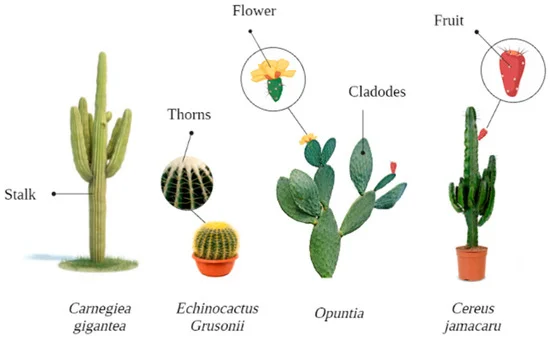When one gazes upon a splendid display of cacti, a playful question emerges: How many types of these resilient plants can one truly identify? The vast diversity of cactus species can pose a delightful challenge to both casual observers and avid horticulturists alike. Indeed, these remarkable plants not only captivate our imagination but also offer a plethora of varieties each with unique characteristics and adaptations. Understanding the classification of cactus plants is essential to appreciate the beauty and complexity of these hardy organisms.
It is essential to delve into the classification of cacti, which primarily falls under the family Cactaceae. This family is distinguished by unique anatomical features such as modified stems (often spiny), intricate flowering mechanisms, and the capacity to store water in desiccated environments. Broadly, cacti can be categorized into two primary groups based on their growth form: columnar and globular species. Yet, the nuances of classification extend into an intricate web of genera and species, all of which share common adaptations to thrive in arid surroundings.
Diving into the Distinct Growth Forms
Growth form plays a pivotal role in the identification and classification of cacti. The two principal forms—columnar and globular—exhibit notable differences, each adapted to specific ecological niches.
Columnar Cacti: The Towering Sentinels
Columnar cacti are characterized by their tall, upright growth, often resembling pillars or trees. These species, such as the Saguaro (Carnegiea gigantea), can reach impressive heights, sometimes exceeding 40 feet. Their elongated structure allows them to capture sunlight efficiently, which is vital for photosynthesis in the harsh desert climate. Additionally, the ribbed structure of many columnar cacti facilitates the expansion of the plant during periods of rainfall, allowing them to store substantial quantities of water.
Another striking species within this group is the Organ Pipe Cactus (Stenocereus thurberi), known for its multi-branching arms that create a stunning visual display. The flowers of columnar cacti are typically large and often open at night, attracting nocturnal pollinators such as bats and moths.
Globular Cacti: The Cute and Compact
Globular cacti, also known as ball cacti or spherical cacti, take on a vastly different appearance. These diminutive plants, such as the famous Golden Barrel Cactus (Echinocactus grusonii), present a charming round shape that is perfect for forming clusters in rock gardens or indoor collections. Their spherical form minimizes surface area, hence reducing water loss, a vital adaptation for survival in severe climates.
Globular cacti are often adorned with stunning spines that can range from soft and feathery to long and sharp, creating a protective deterrent against herbivores. Furthermore, many of these species produce vibrant flowers that bloom atop the globe, enchanting observers and providing a vital resource for pollinators.
The Diverse Genera: A Closer Look
After establishing the major growth forms, it is important to explore the various genera within the Cactaceae family. Each genus comprises multiple species with their own distinctive features, adaptations, and morphological characteristics.
Opuntia: The Prickly Pears
One of the largest and most diverse genera is Opuntia, commonly known as prickly pears. Within this genus, one can find species exhibiting a variety of growth forms, including flat pads and elongated segments. Prickly pears are known for their edible fruits (called tunas) and pads (known as nopales), both of which are staples in culinary applications across numerous cultures. In addition to their culinary value, these cacti possess bright, showy flowers that attract a multitude of pollinators.
Interestingly, many Opuntia species have adapted to survive harsh climates by developing unique mechanisms to store water, resulting in their widespread presence in arid regions globally.
Schlumbergera: The Beloved Holiday Cactus
Schlumbergera, commonly known as the Christmas or Thanksgiving cactus, is another captivating genus, distinguished by its segmented stems and vibrant blossoms that adorn indoor spaces during the holiday season. Unlike many cacti that thrive in dry, arid conditions, these epiphytic cacti originate from the humid rainforests of Brazil. Their unique growth strategy revolves around their capacity to absorb moisture from the air, enabling them to flourish in environments that are less hospitable to traditional desert-dwelling cacti.
This genus showcases flowers in a range of captivating colors, adding a festive charm that has made them a popular choice for holiday gifting and indoor decor.
Exploring the Varieties: From Common to Rare
Within the broader categories and genera, one discovers an astonishing variety of cactus species, each showcasing its own idiosyncrasies. From the iconic golden spines of the Echinocactus grusonii to the stunning blooms of the Gymnocactus, the myriad of choices can be overwhelming for enthusiasts. While many cacti are readily available in commercial nurseries, others remain obscure and elusive, appealing to dedicated collectors.
Cactus enthusiasts often embark on quests to cultivate rare varieties, leading to the formation of clubs and societies dedicated to the conservation and cultivation of these splendid plants. The challenge lies not only in caring for these remarkable organisms but also in understanding their distinct needs, growth patterns, and potential threats in their native habitats.
In conclusion, the classification of cactus plants is a rewarding endeavor that opens up a world filled with extraordinary diversity and resilient adaptations. Whether exploring columnar giants, globular charms, or the fascinating diverse genera, one can appreciate the wonder of these extraordinary plants. So, as you ponder your own cactus collection, will you embrace the challenge and delve deeper into the enchanting realm of cacti? The adventure awaits!





Leave a Comment